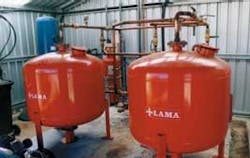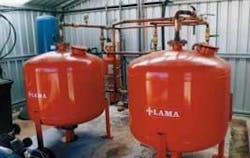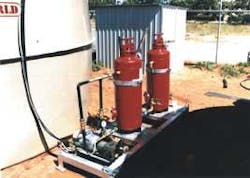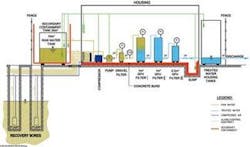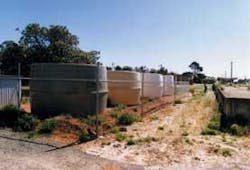New treatment techniquecleans up arsenic at former railways site
By Christian End, David Steele
This project marked the first time GFH was used to treat high concentrations of arsenic in groundwater that had resulted from historical operations at an industrial site, where arsenic concentrations in groundwater significantly exceeded Australian drinking water guidelines.
URS Australia Pty Ltd (part of the international URS Corporation) in South Australia undertook design, trialing, construction and operation of the groundwater treatment plant, initially on behalf of Indec Consulting. The remedial works were part of a multi-million dollar program of environmental assessment and remediation associated with the transfer of former Australian National railways assets to the state government. Indec Consulting managed the process on behalf of the Commonwealth Department of Transport and Regional Services. Following handover of assets to the state government of South Australia, the remedial works continued to be funded by Transport SA, the state government agency with responsibility for the site.
Arsenic-based pesticides had been historically used along the railway corridor for weed control, typically resulting in relatively diffuse arsenic contamination along the corridors. The concentrated arsenic plume in groundwater at the remediation site may have resulted from activities such as filling or cleanout of the "poison train" used for pesticide application, or possibly from more intensive application at this location.
The contamination was manifested in a relatively localised plume within groundwater beneath the site, which lies within a fractured rock aquifer some 15 m below the ground surface. The nature of the fractured rock aquifer and variability in arsenic concentrations precluded accurate estimation of the quantity of arsenic present in groundwater.
The objective of the project was to select and design a groundwater remediation system to meet site-specific requirements and achieve efficient and cost-effective cleanup. Following a thorough assessment of available options, the following groundwater remediation strategy was selected:
• Install and operate a groundwater pump-and-treat system with on-site groundwater treatment.
• Use GFH as an absorbent filter material for the treatment of arsenic in the extracted groundwater.
• Implement a regular monitoring program to assess the performance of the remediation system and potential filter break-through.
• Discharge suitably treated groundwater to the local stormwater system.
URS conducted a three-month pilot trial, using a specifically designed treatment plant to test the proposed system's efficiency and suitability for long-term application under site conditions. During the pilot trial, project engineers paid particular attention to arsenic absorption rates of the GFH filters, estimated amounts of required GFH, achievable concentrations of arsenic in treated water, and competing absorbing substances, such as phosphate. Results suggested that GFH was capable of treating very high arsenic concentrations down to concentrations below the stringent Australian drinking water guidelines.
URS undertook the remedial design based on the results of the pilot trial, and a full-scale remediation system was subsequently constructed by URS incorporating six recovery bores for extraction of contaminated groundwater, and a groundwater treatment plant. The recovery bores are equipped with frequency-controlled submersible pumps, which enable groundwater extraction to match the yield of the aquifer. The groundwater treatment plant includes the following components:
• A 10-m3 water tank for temporary storage of raw water prior to treatment;
• An automatically operated on-site treatment plant which includes one gravel filter and three GFH fixed-bed filters (two filters containing 1,000 kg and one filter containing 500 kg of GFH), piping, a water transfer pump, and control/alarm equipment;
• Three holding tanks for temporary storage of clean water prior to discharge; and
• A pipeline from clean water holding tanks to the local stormwater system for discharge of treated water.
The treatment plant incorporates three GFH filters.
The first filter captures the majority of the arsenic, the second as a backup/polishing filter, and the third as a contingency only, ensuring that treatment goals are met at all times. Based on pilot trial data, filter dimensions were designed to achieve sufficient contact time for the water passing through the filters to be adequately treated. The optimum contact time was determined to be three times the empty filter bed volume per hour. Despite the groundwater pumping rate being increased during the course of operation, the remediation system has proven to be reliable in achieving treatment targets.
Safety was a prime consideration since the project site is located in a remote area without permanent supervision. Project engineers installed a secondary containment and state-of-the-art alarm system to detect spillage and prevent discharge of contaminated water to the ground surface. The system includes a double-wall raw water holding tank and double-lined water pipelines from the bores to the treatment plant; a wireless alarm device programmed to shut down the system in case of technical malfunction and send an SMS alarm message to maintenance personnel and project managers; and a float sensor installed in a floor sump beneath the treatment plant (which is itself within a concrete bund), programmed to shut down the system if there is any leakage or spillage from the filters.
The full-scale remediation system was operated for almost two years, and the benefits of using GFH in the treatment process during this time met expectations. At present the system has been shut down to permit monitoring of the groundwater contamination status and remediation effectiveness.
The system performance itself has exceeded expectations; the mass of arsenic recovered from the contamination plume has been more than 20 kg, significantly greater than initial forecasts. All water quality treatment targets have been met, and the system has proven to be simple to operate and reliable. Spent GFH has been accepted to landfill following satisfactory multiple-extraction leach tests.
GFH benefits
Numerous arsenic treatment techniques have been developed over the years; however some have technical deficiencies, such as inadequate treatment performance, high operational and manpower requirements, creation of hazardous wastes and high costs. The new technique can be applied in a controlled manner without the need for complex and high-maintenance treatment plants.
GFH, a high-performance absorbent filter material, was initially developed and used to selectively remove arsenic from groundwater and make it safe for drinking. It was used chiefly in areas where arsenic occurred naturally in groundwater and concentrations were typically low but higher than regulatory guidelines. GFH has numerous advantages over traditional arsenic-treatment technologies such as coagulation with ferric salts, ion exchange, reverse osmosis, and activated alumina.
GFH is safer than other treatment methods because the material is non-toxic and no hazardous sludge is created, as is the case with other techniques. Its application in fixed-bed filters is relatively simple, and operation and maintenance requirements are minimal. In addition, the little residual mass of spent filter material can generally be disposed of to landfill, without further treatment. GFH technology is also less costly than competing systems.
The non-toxic GFH can be stored and handled without specific safety standards, which significantly reduces operational health and safety requirements for staff and subcontractors handling the new and spent filter material. This quality was particularly beneficial given the remote location of the site from the Adelaide project office.
The project also afforded a number of collateral benefits along with preservation of groundwater quality. The District Council of Peterborough was able to use the treated water for road maintenance/ dust control purposes, and the use of local contractors for installation of much of the relatively low-technical treatment plant benefited the local community.
The new technology is likely to be adapted to similar sites and sites associated with other industries such as mining and timber treatment, where the historical application or use of arsenic may have resulted in groundwater contamination.
Authors' NoteChristian End is the office manager of URS Corporation in Frankfurt, Germany. David Steele is the principal environmental engineer of URS Australia Pty Ltd, located in Hackney, South Australia.
